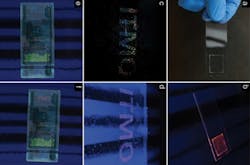Inkjet-printed nanoparticle ink can produce security holograms on an industrial scale
Researchers at ITMO University (St. Petersburg, Russia) have unveiled a new approach to printing luminescent structures based on nanoparticle ink. The unique optical properties of the ink were achieved by means of europium-doped zirconia.1
Particles of this material were proven to be useful in manufacturing luminescent holographic coatings with a high degree of protection. Notably, the developed approach enables the fabrication of custom holograms (including security holograms) by means of a simple inkjet printer. These luminescent nanoparticles can also be used to produce biosensors and to visualize cancer cells.
"Europium-doped zirconium dioxide is a material that has been studied and used by researchers all over the world for decades," says Alexandr Vinogradov, co-author of the research and head of ITMO University’s Biochemistry Cluster. "However, our research is novel in that it uses the material to protect the surface of rainbow holograms. To this end, we had to achieve certain features in the material. In particular, the nanoparticles contained in the ink must be close to identical in size. Strict requirements are also imposed by rheological parameters that determine the viscosity of the material—otherwise, the ink might not be suitable for inkjet printing. Our goal was to transform a material that was initially synthesized in a test tube into a stable colloid that could be printed and applied to any surface. Our study describes the exact process of creating such functional ink."
The researchers note that the product is ready for practical application. The ink is compatible with currently existing printhead types and can be used with existing manufacturing capabilities.
Source: http://news.ifmo.ru/en/science/new_materials/news/6884
REFERENCE:
1. Aleksandra Furasova et al., Nanoscale (2017); doi: 10.1039/C7NR03175K.

John Wallace | Senior Technical Editor (1998-2022)
John Wallace was with Laser Focus World for nearly 25 years, retiring in late June 2022. He obtained a bachelor's degree in mechanical engineering and physics at Rutgers University and a master's in optical engineering at the University of Rochester. Before becoming an editor, John worked as an engineer at RCA, Exxon, Eastman Kodak, and GCA Corporation.
